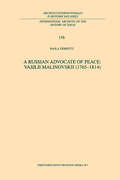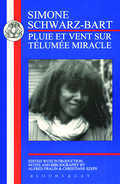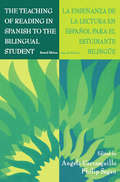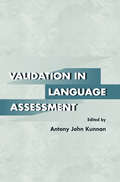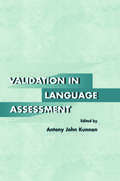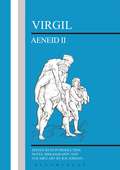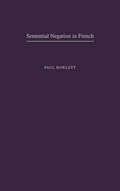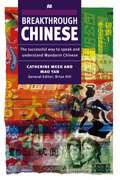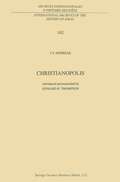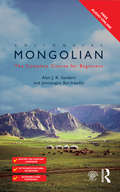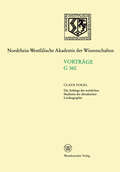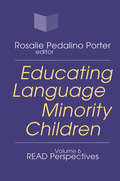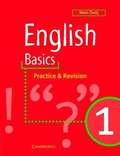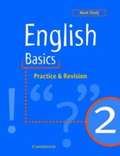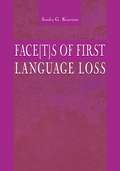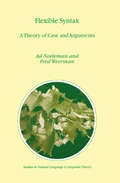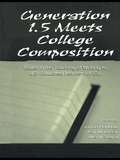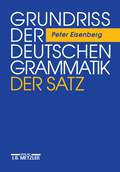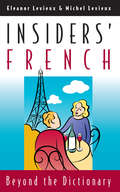- Table View
- List View
A Russian Advocate of Peace: Vasilii Malinovskii (International Archives of the History of Ideas Archives internationales d'histoire des idées #156)
by P. FerrettiVasilii Fedorovich Malinovskii (1765-1814) is a name which has hitherto lacked true resonance in the history of Russian culture. Tt is of course a name known to all students of Alexander Pushkin's biography, for Malinovskii was the first Director of the new Tsarskoe Selo Lyceum, if, sadly, for only the first three of the young poet's years at the school. For those scholars conversant with the intellectual and literary life of the "beautiful beginning" of the reign of Alexander I's reign Malinovskii has his little niche for his remarkable Rassuzhdenie 0 mire i voine (1803) and less for his Osennie vechera (1803), a little-known journal limited to a mere eight weekly issues and written entirely by the editor. As regards the of his 'eighteenth-century' Malinovskii, who lived the first thirty-five years life predominantly in the reign of the great Catherine, little information encumbers the memory of even specialists of the period. Indeed, his elder brother, Aleksei Fedorovich (1762-1840), is the more likely to be remembered for his literary and translating work as well for his later position as Head of the Moscow Archive of the Ministry of Foreign Affairs, which brought him into contact with Pushkin and, not unexpectedly, with Karamzin. Karamzin referred to him as "one of my few old and genuine friends", but one searches in vain for a similar accolade for VasiIii Fedorovich.
Schwarz-Bart: Pluie et Vent sur Télumée Miracle
by Simone Schwarz-Bart Alfred Fralin Christiane SzepsGreat-granddaughter of Minerve, first woman of the Guadeloupean branch of the Lougandor family to be freed from slavery in 1848, the elderly Telumée tells the story of her own difficult life and that of her ancestors. It is a poor black woman's tale of heroic survival, set in the early 20th century, harsh agrarian environment of a Caribbean island.Through the richly imaged narration of a constantly evolving, cultural significant and always entertaining saga, the author leads the reaer into her native West Indian realm of legends, magic, folkloric wisdom and traditional reverence for the elderly and the past. Her protagonist, Telumée, embodies the innate strength and nobility of women in general and of black Caribbean women in particular.Published in 1972, this book received Elle magazine's literary prize. This edition reflects the editor's personal acquaintance with the author, and her country. It provides a synthesis of the latest critical studies, and a thorough interpretation of Creole terms, symbolic imagery and a unique cultural background.
The Teaching of Reading in Spanish to the Bilingual Student: La Ense¤anza De La Lectura En Espa¤ol Para El Estudiante Biling e
by Angela Carrasquillo Philip SeganThis dual-language text provides theory and methodology for teaching reading in Spanish to Spanish/English bilingual or Spanish-dominant students. The goal is to help educators teach these students the skills necessary to become proficient readers and, thus, successful in the school system. At the very core of the book are the hispano-parlantes--the Spanish-speaking children--who bring to the schools, along with their native language and cultures, a wealth of resources that must be tapped and to whom all educators have a responsibility to respond. True to the concepts of developing bilingual educators to serve bilingual students, the text presents chapters in English and Spanish. Each chapter is written in only one language at the preference of the author. Thus, to be successful with this book, the reader must be bilingual. Themes emphasized in the text include current reading methodologies, the concept of reading as developmental literacy skills, reading in the content areas, new views of the development of proficiency in the second language, issues related to students with special learning needs, assessment, and the uses of technology in the delivery of instruction. Never losing sight of its goal--to teach reading in Spanish to bilingual or Spanish-dominant students--the book includes a series of focusing questions and follow-up activities; these are not simply translations of existing activities, strategies, and techniques intended for monolingual English students, but specifically designed to be appropriate for Spanish-speaking students. Directed to university preservice and in-service instructors of reading and bilingual education as well as administrators and district- and school-level staff developers who work with Hispanic populations, the book is sensitive at all times to nuances of the languages and cultures of the intended audiences.
The Teaching of Reading in Spanish to the Bilingual Student: La Ense¤anza De La Lectura En Espa¤ol Para El Estudiante Biling e
by Angela Carrasquillo Philip SeganThis dual-language text provides theory and methodology for teaching reading in Spanish to Spanish/English bilingual or Spanish-dominant students. The goal is to help educators teach these students the skills necessary to become proficient readers and, thus, successful in the school system. At the very core of the book are the hispano-parlantes--the Spanish-speaking children--who bring to the schools, along with their native language and cultures, a wealth of resources that must be tapped and to whom all educators have a responsibility to respond. True to the concepts of developing bilingual educators to serve bilingual students, the text presents chapters in English and Spanish. Each chapter is written in only one language at the preference of the author. Thus, to be successful with this book, the reader must be bilingual. Themes emphasized in the text include current reading methodologies, the concept of reading as developmental literacy skills, reading in the content areas, new views of the development of proficiency in the second language, issues related to students with special learning needs, assessment, and the uses of technology in the delivery of instruction. Never losing sight of its goal--to teach reading in Spanish to bilingual or Spanish-dominant students--the book includes a series of focusing questions and follow-up activities; these are not simply translations of existing activities, strategies, and techniques intended for monolingual English students, but specifically designed to be appropriate for Spanish-speaking students. Directed to university preservice and in-service instructors of reading and bilingual education as well as administrators and district- and school-level staff developers who work with Hispanic populations, the book is sensitive at all times to nuances of the languages and cultures of the intended audiences.
Validation in Language Assessment
by Antony John KunnanValidation in Language Assessment contributes to the variety of validation approaches and analytical and interpretive techniques only recently adopted by language assessment researchers. Featuring selected papers from the 17th Language Testing Research Colloquium, the volume presents diverse approaches with an international perspective on validation in language assessment.
Validation in Language Assessment
by Antony John KunnanValidation in Language Assessment contributes to the variety of validation approaches and analytical and interpretive techniques only recently adopted by language assessment researchers. Featuring selected papers from the 17th Language Testing Research Colloquium, the volume presents diverse approaches with an international perspective on validation in language assessment.
Virgil: Aeneid Ii (Latin Texts Ser.)
by Virgil R. H. JordanIn Book II of the "Aeneid", Aeneas relates to Dido his own account of Troy's destruction and his escape, including the episode of the Wooden Horse. It is some of the best Latin poetry ever written, and thus makes an ideal introduction to the "Aeneid". This completely new edition aims to provide students with help in translation, encourage them to consider the sound of the poetry, and appreciate the emotional impact of the story as Virgil portrays it. The text also includes a general introduction, a select bibliography, notes and a full vocabulary; appendices deal with meter and scansion.
Sentential Negation in French
by Paul RowlettThis is the first full-length study of sentential negation phenomena in French. Paul Rowlett assesses, from a generative perspective, the respective contribution made to the expression of clausal polarity by ne, pas, and elements such as jamais and personne. His conclusions have far-reaching implications, leading to the controversial hypothesis that, despite widespread belief, French is not a negative concord language.
Breakthrough Chinese
by Catherine MeekA new approach to the teaching of Mandarin Chinese, this course concentrates on the essentials needed for everyday situations while travelling in China and provides a sound basis for further study. Based on authentic recordings made on location in Beijing, it exposes the learner to the genuine sound of the language, supported by carefully explained notes and scripted studio recordings with a wealth of practice activities. Unlike other Mandarin Chinese courses it focuses heavily on listening and speaking skills, backed up by simple, clear but short grammar explanations and exercises. One page in each of the fifteen units is devoted to providing fascinating background detail about China and the Chinese. Pinyin is used throughout rather than the Chinese characters.
Christianopolis (International Archives of the History of Ideas Archives internationales d'histoire des idées #162)
by Mark H. EbellJohann Valentin Andrere (1586-1654) was a multi-faceted product of late Reformation Germany. A theologian who was firmly committed to the Lutheran confession, he could yet see very c1early the flaws in his church and argue for their reform; without being an ecumenicist in the modern sense, he yet admired many aspects of the society he observed in Calvinist Geneva, and he recognised the outstanding merit of individual Catholic scholars. A linguist and a lover of art and music, he was the friend of scientists and an enthusiastic student of mathematics whö held that science leads both to an appreciation of the wonders of the material world and its rejection in favour of more spiritual concerns. In his satirical writing he could be ironic and flippant, his rhetoric was often laboured and over elaborate, but there is no mistaking the sincerity of his outrage at cruelty, inhumanity and injustice. Andrere was optimistic, in that he believed that the corruption and deceit, the luxm. y and deprivation, the hypocrisy, tyranny and sophistry of the age could be transformed in a second reformation; yet there runs through his life a deep-rooted pessimism or depression which makes his willingness to continue the struggle all the more admirable. As early as 1618, while still a young deacon at the beginning of his career, he defined the four ages of l human life as terror, error, labor and horror.
Colloquial Mongolian: The Complete Course for Beginners (Colloquial Ser.)
by Jantsangiyn Bat-Ireedui Alan J SandersColloquial Mongolian is easy to use and completely up to date! Written by experience teachers of the language, Colloquial Mongolian offers a step-by-step approach to written and spoken Mongolian. No previous knowledge of the language is required. Features include: Guide to reading and writing the alphabet Lively dialogues in true-to-life situations Concise grammar explanations A variety of exercises with full answer key, grammar summary, suffix index and two-way glossary Explanatory notes on Mongolian culture and customs By the end of this rewarding course you will be able to communicate confidently and effectively in Mongolian in a broad range of everyday situations. Audio material to accompany the course is available to download free in MP3 format from www.routledge.com/cw/colloquials. Recorded by native speakers, the audio material features the dialogues and texts from the book and will help develop your listening and pronunciation skills.
Colloquial Mongolian: The Complete Course for Beginners (Colloquials Ser.)
by Jantsangiyn Bat-Ireedui Alan J SandersColloquial Mongolian is easy to use and completely up to date! Written by experience teachers of the language, Colloquial Mongolian offers a step-by-step approach to written and spoken Mongolian. No previous knowledge of the language is required. Features include: Guide to reading and writing the alphabet Lively dialogues in true-to-life situations Concise grammar explanations A variety of exercises with full answer key, grammar summary, suffix index and two-way glossary Explanatory notes on Mongolian culture and customs By the end of this rewarding course you will be able to communicate confidently and effectively in Mongolian in a broad range of everyday situations. Audio material to accompany the course is available to download free in MP3 format from www.routledge.com/cw/colloquials. Recorded by native speakers, the audio material features the dialogues and texts from the book and will help develop your listening and pronunciation skills.
Die Anfänge des westlichen Studiums der altindischen Lexikographie (Nordrhein-Westfälische Akademie der Wissenschaften #360)
by Claus VogelEducating Language Minority Children
by Rosalie PorterREAD Perspectives, a refereed annual publication of the Institute for Research in English Acquisition and Development (READ), Washington, D.C., begins its sixth year with the theme "Educating Language Minority Children: An Agenda for the Future." Volume 6 features presentations from a Boston University conference organized by READ and the Pioneer Institute. The essays represent truly diverse viewpoints on the education of limited-English students, rare in the complex and contentious arena of bilingual education.The lead article, "Rethinking Bilingual Education," by Charles L Glenn of Boston University, inspired the conference's organization. Dr. Glenn proposes new ways of schooling limited-English-speaking children that depart dramatically from the practices of the past 30 years. He proposes sound recommendations for revising Massachusetts bilingual education law, ideas that could well be applied in other states. Also included areChristine Rossell's "Mystery on the Bilingual Express," a critique of the controversial study by Thomas and Collier; Rosalie Pedalino Porter's follow-up review of El Paso, Texas's programs for English learners; Mark Lopez's "Labor Market Effects of Bilingual Education"; "Bethlehem, Pennsylvania's English Acquisition Program," by Thomas J. Dolusio; Maria Estela Brisk's discussion on the need to restructure schools to incorporate the large non-English student population; several articles regarding educational reform in Massachusetts, including two by school superintendents Eugene Creedon and Douglas Sears, and one by Harold Lane, Chairman of the Joint Education Committee in the Massachusetts Legislature; and, finally, Kevin Clark's "From Primary Language Instruction to English Immersion: How Five California Districts Made the Switch." Kevin Clark's California study "From Primary Language Instruction to English Immersion: How Five California Districts Made the Switch," describes how radical changes are being carried out in a few representative school districts since passage of California Proposition 227, the "English for the Children" initiative. Educating Language Minority Children is a valuable selection of the most current thinking on policies, programs, and practices affecting limited-English students in U.S. public schools. It provides a wealth of practical information useful to educators, parents, legislators, and policy analysts, and is an essential addition to libraries nationwide.
Educating Language Minority Children
by Rosalie PorterREAD Perspectives, a refereed annual publication of the Institute for Research in English Acquisition and Development (READ), Washington, D.C., begins its sixth year with the theme "Educating Language Minority Children: An Agenda for the Future." Volume 6 features presentations from a Boston University conference organized by READ and the Pioneer Institute. The essays represent truly diverse viewpoints on the education of limited-English students, rare in the complex and contentious arena of bilingual education.The lead article, "Rethinking Bilingual Education," by Charles L Glenn of Boston University, inspired the conference's organization. Dr. Glenn proposes new ways of schooling limited-English-speaking children that depart dramatically from the practices of the past 30 years. He proposes sound recommendations for revising Massachusetts bilingual education law, ideas that could well be applied in other states. Also included areChristine Rossell's "Mystery on the Bilingual Express," a critique of the controversial study by Thomas and Collier; Rosalie Pedalino Porter's follow-up review of El Paso, Texas's programs for English learners; Mark Lopez's "Labor Market Effects of Bilingual Education"; "Bethlehem, Pennsylvania's English Acquisition Program," by Thomas J. Dolusio; Maria Estela Brisk's discussion on the need to restructure schools to incorporate the large non-English student population; several articles regarding educational reform in Massachusetts, including two by school superintendents Eugene Creedon and Douglas Sears, and one by Harold Lane, Chairman of the Joint Education Committee in the Massachusetts Legislature; and, finally, Kevin Clark's "From Primary Language Instruction to English Immersion: How Five California Districts Made the Switch." Kevin Clark's California study "From Primary Language Instruction to English Immersion: How Five California Districts Made the Switch," describes how radical changes are being carried out in a few representative school districts since passage of California Proposition 227, the "English for the Children" initiative. Educating Language Minority Children is a valuable selection of the most current thinking on policies, programs, and practices affecting limited-English students in U.S. public schools. It provides a wealth of practical information useful to educators, parents, legislators, and policy analysts, and is an essential addition to libraries nationwide.
English Basics 1: Practice And Revision
by Mark CholijCover the 'mechanics' of English language. Provides an introduction to the basic principles of the English language for 9-11 year-olds. Also suitable as a revision book for older children.
English Basics 2: Practice And Revision (PDF)
by Mark CholijCover the 'mechanics' of English language. For students aged 11+ who need to revise the general principles of English language and grammar.
Face[t]s of First Language Loss
by Sandra G. KouritzinThis book contributes to the understanding of first-language loss in both immigrant and indigenous communities in (at least) three ways. First, it provides insight into the process of language loss and the factors contributing to it. Second, it attempts to define, from an insider perspective, what it means to "lose" a language. Third, it analyzes the perceived consequences of first language loss in terms of social, academic, emotional, and economic factors--an approach previously lacking in research on language loss. Most studies of first language loss are impersonal, even when they tell emotional stories. This polyphonic book about language loss and imperfect learning of heritage languages tells the inside story. Easy to read and yet academic, it gives voice to five different storytellers who relate the histories of their first language loss and analyzes themes from 21 life-history case studies of adults who had lost their first languages while learning English. The stories in this book make a compelling argument that heritage languages should be preserved, that ESL should be about developing bilinguals not English monolinguals. Important reading for researchers, practitioners, and graduate students in ESL and bilingual education, multicultural education, cultural studies, and sociology, this book will also interest qualitative researchers as an example of a unique form of both doing and writing research.
Face[t]s of First Language Loss
by Sandra G. KouritzinThis book contributes to the understanding of first-language loss in both immigrant and indigenous communities in (at least) three ways. First, it provides insight into the process of language loss and the factors contributing to it. Second, it attempts to define, from an insider perspective, what it means to "lose" a language. Third, it analyzes the perceived consequences of first language loss in terms of social, academic, emotional, and economic factors--an approach previously lacking in research on language loss. Most studies of first language loss are impersonal, even when they tell emotional stories. This polyphonic book about language loss and imperfect learning of heritage languages tells the inside story. Easy to read and yet academic, it gives voice to five different storytellers who relate the histories of their first language loss and analyzes themes from 21 life-history case studies of adults who had lost their first languages while learning English. The stories in this book make a compelling argument that heritage languages should be preserved, that ESL should be about developing bilinguals not English monolinguals. Important reading for researchers, practitioners, and graduate students in ESL and bilingual education, multicultural education, cultural studies, and sociology, this book will also interest qualitative researchers as an example of a unique form of both doing and writing research.
Flexible Syntax: A Theory of Case and Arguments (Studies in Natural Language and Linguistic Theory #47)
by A. Neeleman F. WeermanMost linguistic theories assume that each grammatical relation is established in a unique structural configuration. Neeleman and Weerman take issue with this view, arguing for a more flexible approach on the basis of conceptual considerations and data taken mostly, but not exclusively, from the Germanic languages. In-depth analyses of word order phenomena as well as diachronic and typological generalizations motivate a re-evaluation of the role of case in the projection of arguments. Case is shown to provide a syntactic foothold for thematic interpretation, something which is necessary in a grammar that does not allow fixed theta-positions. Thus, this study does not only offer a genuine alternative to many standard assumptions, it also explains why there should be such a thing as case in natural language.
Generation 1.5 Meets College Composition: Issues in the Teaching of Writing To U.S.-Educated Learners of ESL
by Linda Harklau Kay M. Losey Meryl SiegalAn increasing number of students graduate from U.S. high schools and enter college while still in the process of learning English. This group--the "1.5 generation"--consisting of immigrants and U.S. residents born abroad as well as indigenous language minority groups, is rapidly becoming a major constituency in college writing programs. These students defy the existing categories in most college writing programs, and in the research literature. Experienced in American culture and schooling, they have characteristics and needs distinct from the international students who have been the subject of most research and literature on ESL writing. Furthermore, in studies of mainstream college composition, basic writing, and diversity, these students' status as second-language learners is usually left unaddressed or even misconstrued as underpreparation. Nevertheless, research and pedagogical writings have yet to take up the particular issues entailed in teaching composition to this student population. The intent in this volume is to bridge this gap and to initiate a dialogue on the linguistic, cultural, and ethical issues that attend teaching college writing to U.S.-educated linguistically diverse students. This book is the first to address explicitly issues in the instruction of "1.5 generation" college writers. From urban New York City to midwestern land grant universities to the Pacific Rim, experienced educators and researchers discuss a variety of contexts, populations, programs, and perspectives. The 12 chapters in this collection, authored by prominent authorities in non-native language writing, are research based and conceptual, providing a research-based survey of who the students are, their backgrounds and needs, and how they are placed and instructed in a variety of settings. The authors frame issues, raise questions, and provide portraits of language minority students and the classrooms and programs that serve them. Together, the pieces paint the landscape of college writing instruction for 1.5 generation students and explore the issues faced by ESL and college writing programs in providing appropriate writing instruction to second-language learners arriving from U.S. high schools. This book serves not only to articulate an issue and set an agenda for further research and discussion, but also to suggest paths toward linguistic and cultural sensitivity in any writing classroom. It is thought-provoking reading for college administrators, writing teachers, and scholars and students of first- and second-language composition.
Generation 1.5 Meets College Composition: Issues in the Teaching of Writing To U.S.-Educated Learners of ESL
by Linda Harklau Kay M. Losey Meryl SiegalAn increasing number of students graduate from U.S. high schools and enter college while still in the process of learning English. This group--the "1.5 generation"--consisting of immigrants and U.S. residents born abroad as well as indigenous language minority groups, is rapidly becoming a major constituency in college writing programs. These students defy the existing categories in most college writing programs, and in the research literature. Experienced in American culture and schooling, they have characteristics and needs distinct from the international students who have been the subject of most research and literature on ESL writing. Furthermore, in studies of mainstream college composition, basic writing, and diversity, these students' status as second-language learners is usually left unaddressed or even misconstrued as underpreparation. Nevertheless, research and pedagogical writings have yet to take up the particular issues entailed in teaching composition to this student population. The intent in this volume is to bridge this gap and to initiate a dialogue on the linguistic, cultural, and ethical issues that attend teaching college writing to U.S.-educated linguistically diverse students. This book is the first to address explicitly issues in the instruction of "1.5 generation" college writers. From urban New York City to midwestern land grant universities to the Pacific Rim, experienced educators and researchers discuss a variety of contexts, populations, programs, and perspectives. The 12 chapters in this collection, authored by prominent authorities in non-native language writing, are research based and conceptual, providing a research-based survey of who the students are, their backgrounds and needs, and how they are placed and instructed in a variety of settings. The authors frame issues, raise questions, and provide portraits of language minority students and the classrooms and programs that serve them. Together, the pieces paint the landscape of college writing instruction for 1.5 generation students and explore the issues faced by ESL and college writing programs in providing appropriate writing instruction to second-language learners arriving from U.S. high schools. This book serves not only to articulate an issue and set an agenda for further research and discussion, but also to suggest paths toward linguistic and cultural sensitivity in any writing classroom. It is thought-provoking reading for college administrators, writing teachers, and scholars and students of first- and second-language composition.
Grundriss der deutschen Grammatik: Band 2: Der Satz
by Peter EisenbergDer vorliegende Band gibt eine umfassende Einführung in die Formen- und Satzlehre des Deutschen. Besonderer Wert ist auf begriffliche Präzision und Verständlichkeit gelegt. Mit über 200 Arbeitsaufgaben zum Selbststudium.
Insiders' French: Beyond the Dictionary
by Eleanor Levieux Michel LevieuxIf you had been living in France in the 1990s, the language you would have heard on the radio and television or seen in the newspapers would be far removed from the French language of ten or twenty years ago. The country and its language have changed tremendously in a relatively short period of time, and, as a result, English speakers with a grounding in French can still find themselves struggling to understand terms commonly encountered in contemporary French society. Luckily, Eleanor and Michel Levieux now bring us up to date with their Insiders' French, an utterly entertaining and informative guide to the language of the "new France." This "new France" is a country poised to experience the European single currency but uncertain about being part of Europe. It is hooked on fast food but ambivalent about the country where it originated. France today has record unemployment and an increasingly controversial immigrant population. Clearly, given the rapidly changing conditions and lifestyles, conventional French dictionaries alone cannot completely inform readers and visitors. Insiders' French offers a solution to the incomprehension, a unique handbook in which you'll find the language of European union, the space program, abortion and women's rights, high-tech industries, and health care, among other topics. Entries proceed by association of ideas and related terms, with extensive cross-referencing, while still being alphabetized for easy reference like a standard dictionary. Cartoons from major French journals add to your understanding and enjoyment. Insiders' French opens up the secret territory of French politics and culture that is often not understood by visitors or students, and it does so with wit and verve—qualities that remain in the French language despite its recent changes.
Insiders' French: Beyond the Dictionary (Nature Of Human Society Ser.)
by Eleanor Levieux Michel LevieuxIf you had been living in France in the 1990s, the language you would have heard on the radio and television or seen in the newspapers would be far removed from the French language of ten or twenty years ago. The country and its language have changed tremendously in a relatively short period of time, and, as a result, English speakers with a grounding in French can still find themselves struggling to understand terms commonly encountered in contemporary French society. Luckily, Eleanor and Michel Levieux now bring us up to date with their Insiders' French, an utterly entertaining and informative guide to the language of the "new France." This "new France" is a country poised to experience the European single currency but uncertain about being part of Europe. It is hooked on fast food but ambivalent about the country where it originated. France today has record unemployment and an increasingly controversial immigrant population. Clearly, given the rapidly changing conditions and lifestyles, conventional French dictionaries alone cannot completely inform readers and visitors. Insiders' French offers a solution to the incomprehension, a unique handbook in which you'll find the language of European union, the space program, abortion and women's rights, high-tech industries, and health care, among other topics. Entries proceed by association of ideas and related terms, with extensive cross-referencing, while still being alphabetized for easy reference like a standard dictionary. Cartoons from major French journals add to your understanding and enjoyment. Insiders' French opens up the secret territory of French politics and culture that is often not understood by visitors or students, and it does so with wit and verve—qualities that remain in the French language despite its recent changes.
